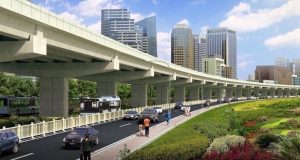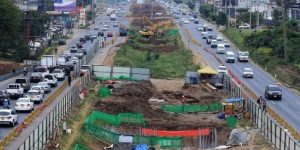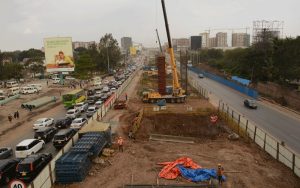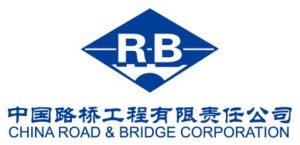The Kenyan government has now made it possible for a company based in China to be able annually adjust the Nairobi Expressway toll charges based on inflation on fees which will be paid in dollars.

The Transport Secretary; James Macharia in a gazette notice published on the 31st of December 2020, revealed that the concessionaire; Moja Expressway which is a subsidiary of the China Road and Bridge Construction (CRBC) will be allowed to review the set base toll rates.
All motorists who use the road that links Mlolongo to the Nairobi to Nakuru Expressway way via the Jomo Kenyatta International Airport (JKIA), will pay between 100 Kenyan Shillings to 1,550 Kenyan Shillings depending of course, on the size of the vehicles as well as the distance travelled.
The above stated rates are based on the United States dollar which is trading at 103.79 Kenyan Shillings. Said rates will subsequently be reviewed based on inflation and the rate of the Kenyan Shilling to the dollar which as at 4th of January 2021, stood at 109.17 Kenyan Shillings.
This basically means that the toll charges are dollar based and will essentially protect the Chinese operator from any losses that could be incurred as a result of exchange rates.
The chinese company that will be responsible for the building and operating of the Nairobi Expressway is expected to earn a profit of around 106.8 Billion Kenyan Shillings for the 27 years that it will oversee the double decker road.

A statement revealed that, “The BRT rates may be adjusted as per the Consumer Pricing Index (CPI) and exchange rate on and after the commercial operation date. The exchange rate on the execution date will be 1USD to Sh103.79.”
The Kenyan Shilling has undergone immense pressure against the dollar over the past couple of months, as a result of the drop in tourism due to the still ongoing Coronavirus pandemic.
All high capacity vehicles like transit lorries for example, will pay between 500 Kenyan Shillings to 1,550 Kenyan Shillings in order to use the expressway and depending on the distance traveled on the road. For low capacity vehicles like saloon cars, user will pay between 100 Kenyan Shillings and 310 Kenyan Shillings according to Business Daily Africa.
Three wheel vehicles more popularly known as Tuk Tuks and Motorcycles more popularly known as Boda Bodas are banned from using the double decker road. Construction began in 2020 and is expected to take a period of two years to complete.

On the 31st of December 2020 the privately funded project was gazetted as a toll road that will continue to be under concession for a period of 27 years starting after said road is commissioned.
The expressway will include a four lane and six lane dual carriageway within the already existing median of Mombasa Road, Uhuru Highway, Waiyaki Way and 11 other interchanges or exits and entry routes that will also be used as toll ramps.
The toll charges are projected to generate around 302.5 Billion Kenyan Shillings in revenue. This translates to a yearly profit of about 3.9 Billion Kenyan Shillings for the Chinese company.
According to Business Daily Africa the projected 3.9 Billion Kenyan Shillings for the China Road and Bridge Construction (CRBC) from the double decker road, is already higher than the profits of majority of the firms listed on the Nairobi Securities Exchange (NSE). It is seen as proof of the outsized money that the expressway will create within the period.

Although Toll fees were first introduced in Kenya in the late 1980s, they were later scrapped by the middle of the 1990s, and replaced with the roads maintenance levy which now stands at 18 Kenyan Shillings per litre of diesel and petrol.
The reemergence of toll fees is seen as a direct consequence of using private investments in government infrastructure to build roads, housing and energy plants. Said investors in return, look to recoup their investments by charges various user fees like tolls.
It is believed that Kenya will be looking to maintain the pace of its expenditure on new infrastructure, by the use of funding from private investors and as a result reduce its budget deficit and borrowing.
Apart from the Nairobi Expressway, the Rironi to Nakuru to Mau Summit road, will also soon be a reality as the Kenyan government has entered into a Public Private Partnership (PPP) with a French Consortium of Companies to facilitate the construction of a 233 kilometre highway at a cost of 160 Billion Kenyan Shillings.
Are there any other topics, news, devices, or categories that you would like us to write on? Feel free to reach out to Mpesa Pay in the comment section.


